OUTDOOR ACTIVITIES IN JAPAN
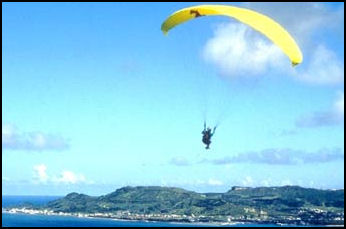
Japanese are very keen on outdoor and adventure sports. For more information and lists of companies involved with the activities listed below contact the Japan National Tourism Organization. Websites: Outdoor Japan Outdoor Japan
Air Sports such as hang gliding, gliding, parachuting and paragliding are practiced in Japan. Scenic airplane flights are offered in some places but are not that common. Parasailing (riding a parachute pulled by a boat) is not really that common either. Paragliding (riding a parachute after running off a hill) is mor popular and offered at some mountain resorts.
Paragliding (parapenting) requires some instruction but still relatively easy to learn and safe. Hang gliding is more difficult and dangerous. There are schools that provide lessons in these sports. Parachute jumping and glider rides are usually organized from regional airports. Flightseeing and hot air ballooning trips are usually arranged in conjunction with tour companies.
Websites: Saga International Balloon Festival Saga Balloon Festival ; Paragliding in Japan Paragliding.net ; Japan Hang and Paragliding AssociationJapan Hang and Paragliding Association
Amusement Parks: Japan is home to roughly 400 amusement parks and theme parks. These includes large famous ones like Tokyo Disneyland and Universal Studios Japan, foreign villages and regular amusement parks. Many have fallen on hard times are struggling or have closed down. For information on Tokyo Disneyland and Universal Studios in Osaka see Tokyo and Osaka under Places. For others such as Space World in Kyushu, Fujikyu Highland Park near Mt. Fuji, Sabrio Puroland in Tokyo, the home of Hello Kitty, Parque Espana in Mie, near Nagoya, and Huis Ten Bosch in Nagasaki See Places.
Ballooning: Sea Air Sports.
Bicycling in Japan
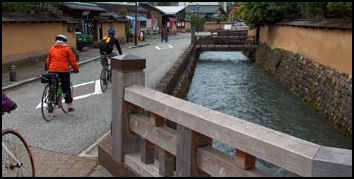
Bicycling is a great way to see Japan. There are many beautiful roads in the mountains, along the coast and through the countryside. The best thing to do is get a good map, pick some country roads and stay off the main roads. Also check the wind direction (mostly from the west) to make sure you have a tailwind not a headwind. There are also tons of dirt roads ideal for mountain biking. Popular mountain biking areas include the Japan Alps, Nagano and the national parks.
The biggest problems is getting your bicycle from place to place. You generally can’t take regular bicycles on the trains (some people take fold up one). Many buses don’t have a luggage area where you can cram a bicycle. This means you have rent a car, rent a bike or ship you bike ahead of you (a very doable option in Japan, using Black Cat shipping and making arrangments at hotel to have them hold your bike.
In the countryside drivers are generally patient and considerate. Watch out for side roads and driveways. Drivers often pull out without stopping or looking. Make sure you have a map. A map in Japanese is okay even if you don't speak Japanese (you can always ask a Japanese bystander if you are on the right road by pointing).
Most airlines allow you take your bike for free on international flights if it is one of your two check-in items. If you bring a bike with you on a plane you have to take off the wheels, pedals, and handlebars and place the bike in a box. In some countries you can carry your bike for free on domestic flights but sometimes there is a fee.
Bicycles can sometimes be rented near train stations and at youth hostels. In some places there are cycling terminals which provide low-cost accommodation for cyclists for about $30 night. For information contact the Japan Bicycle Promotion Institute (☎ 03-3583-5444), Nihon Jitensha Kaikan Building, 1-9-3 Akasaka, Minato-ku, Tokyo
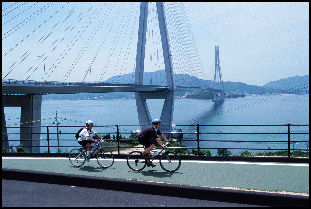
Shimanami Bicycle Route is a 80-kilometer bicycle route that embraces the bridges of Shimanami Route and country roads that parallel the Shimanami Route highway. Visitors can rent bicycle on one side of the route — in either Onomichi or Imbari — and drop it off at a bicycle shop on the other side.
The route is an interesting mix of modern Japanese infrastructure technology and bucolic Inland Sea countryside. Riders and walkers can visit castles, shrines, temples, museums, cafes and restaurants. There are also inns and hotels along where people can stay the night. There are stunning views of the sea and the islands from the bridges. Locals like to tell stories about the Murakami pirates that controlled the waters and the treasures the buried.
The Shimanami Route is the only expressway of the three Honshu-Shikoku bridges that have bicycling-walking lanes on the entire route. Concrete and steel dividers protect cyclist and pedestrians from automobile traffic on the bridges, which range in length for 300 meters to six kilometers, and long, winding approaches to and from the bridges. With the exception of a few hills on Oshima islands, the ramps provide the most clanging ascents and descents. Highlights of the journey include Kosanji temple in Setoda.
Websites: Japan Cycling NavigatorJapan Cycling Navigator ; ; Tokyo Cycling Club Tokyo Cycling Club ; Bike Tours Japan Bike Tours Japan ;Outdoor Japan Outdoor Japan ; Book: Cycling Japan by Bryan Harrell
Beaches:See Sea-Related Activities
Birdwatching in Japan

Japanese cranes Birdwatching in Japan is good in some places but generally poor nationwide. Some good birdwatching spots include the Yamtsu-Higata mud flats near Funabashi in Chiba Prefecture, with large numbers of shorebird and, plovers and sandpipers; the lower slopes of Mount Fuji and the Kawuizawa woodlands, where flycatchers and warblers are observed; and the national parks and lakes in Hokkaido.
In the spring and autumn, Tsushima Island in Nagasaki Prefecture, Hegura Island north of Wajima in Ishikawa Prefecture and Tobishima Island off Iwate Prefecture are good places to watch migrating birds. Popular winter sites include the Kushiro area of Hokkaido for cranes; Lake Izunua in Miyagi Prefecture for swans and geese; and spots west of Izumi city in Kyushu, where 13,000 cranes of five different species second the winter.
Japanese crane, or red-crowned cranes, are arguably the most interesting bird to see in Japan. There are currently about 1,200 Japanese crane in Japan, most of them in Kushiro wetlands in Hokkaido. In the winter the cranes congregate in places where farmers provide then with grain. There are four established feeding centers and several dozen satellite feeding stations — both public and private — in throughout eastern Hokkaido. At the Tsurui-Ito Sanctuary just outside Kushiro National Park, as many as 300 birds gather in the winter for free corn hand outs.
Steller's sea eagles gather in the winter at Nemuro Channel off Hokkaido to feast on small fish known as o-washi in Japan, sometimes resting on platforms of sea ice. Hundreds of swans spend the winter at Kussharo Lake in Akan National Park in Hokkaido, where hot springs keep parts of the lake unfrozen throughout the winter and busloads of tourist throw bread and chips and food to them. The swans have gotten so used to the feeding ritual they sometimes eat out of people’s hands.
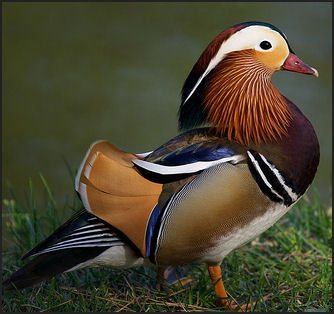
mandarin ducksShunkunitai Wild Bird Sanctuary (near Nemuro in Hokkaido) is one of the best places in Japan to see birds. About 300 species of birds have been spotted here. During the warm months red-crowned cranes can be seen in te marshes between the sandbars. In the winter Stellar's sea eagles, white-tale eagles and snow buntings can be seen. The eagles come to feed on fish scraps left out by fishermen. In October and November, birds which have just fledged chicks in Siberia, arrive in the area and move around in groups with between dozens and hundreds of birds. They eat a kind of water weed known locally as amamo. When the Lake Furen begins to freeze they fly further south and return in March and April to rest and load on food before their long journey back to Siberia. Occasionally people see very are Blakiston's fish owls.
Among the useful guidebooks are “Guide to the Birds of China” by John MacKinnon (Oxford University Press), “A field Guide to the Birds of Russia and Adjacent Territories” by V.E. Flint (Princeton University Press)and a “Birdwatchers's Guide to Japan” by Mark Brazil (Kodansha).
For more information try the Wild Bird Society of Japan (☎03-5358-3513, or Japanese-only website: www.wbsj.org), Katori (e-mail: kantori0subscribe@yahoogroups.com)
Websites: Birds of Japan Gallery by Monte Taylor Birds of Japan ; Birding Hotspots JapanBirding Hotspots Birdwatching in Japan Birding Pal ; Kantori Lode Kantori Lode ; .,
Canoeing and Kayaking in Japan
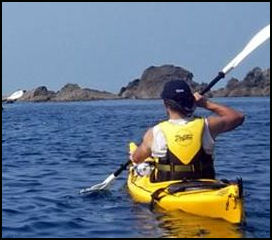
Canoeing and Kayaking is done on wilderness lakes and rivers, and on the sea. Experienced river people can generally rent canoes, rafts and kayaks from outfitters near canoeing rivers or lakes. There are not so many canoeing rivers in Japan. For more information try contacting the Japan National Tourism Organization.
Kayaking is done on on Lake Biwa north of Kyoto. Rentals and lessons are offered from BSC Waterpsorts Center in the lakeside town of Shiga. The wetlands in Kushiro Shitsugen National Park in Hokkaido can be explored in canoes and kayaks. Sea kayaking is popular in Shizuoka area.
Matsushima Bay (20 minutes from Sendai), considered one of Japan's "Three Best Views" in Japan can be explored by kayak, In the town of Onagawa, an ecotourism firm called Earth Quests sponsors kayaking trips for about ¥7,000 a day into sheltered bay and along the coast. The water is very clear and the coral, seaweed and shells in the sea are just as stunning as the pines, jagged rocks and beaches on the land.
Beginners trips last one day and cover about 10 kilometers and included a visit to an oyster farm. Experienced kayakers can embark on multiday tours that involve camping on islands with monkeys and deer. The trips are sometimes called off when the seas are too rough. For more information check the Earth Quest website at www.h5.dion.ne.jp/
Websites: Rivers and Creeks in Japan Rivers and Creeks in Japan ; Outdoor Japan Outdoor Japan ; Canyons.jp Canyons If you google “Kayaking Japan” a lot of different operators in different parts of Japan turn up.
Also see Canoeing, Kayaking and White Water Rafting.
Canyoneering is popular among foreign visitors to Minakamimachi and Gunma Prefecture. Participants wear helmets and mountaineering hats to traverse rapids and waterfall in canyons, A tour company called Canyons guides about 15,000 tourists a year, about 30 percent of them foreigners. Minakamimachi is a two-hour drive from Tokyo.
Cormorant Fishing in Japan
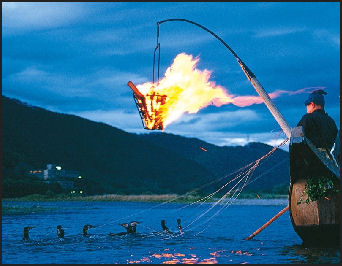
Cormorant Fishing is done at night, except after a heavy rain or during a full moon, from May 11th to October 15th on the Nagaragawa River (near Gifu) and the Oze River in Seki and from June through September on the Kiso River (near Inuyama) not far from Nagoya. It is done in Arashiyama near Kyoto on the Hozu River at night during July and August. Boats that get close enough to see anything charge ¥1,300. Further downstream the Hozu River becomes the Katsura River. It also done in Uji, near Osaka and a couple other places.
The practice of cormorant fishing is over 1000 years old. These days it is performed mostly for the benefit of tourists. The ritual begins when a fire is set or a light is turned on over the water. This attracts swarms of trout-like fish called “ayu” . Tethered cormorants dive into the water and frantically swim around, gulping down fish.
Metal rings and placed around the bird's the neck to keep them from swallowing the fish. When cormorants' gullets are full they are hauled aboard the boat, and the still-moving ayu are disgorged on to the deck. The birds are then given rewards of fish, and thrown back in the river to repeat the process.
The boats are manned by four man teams: a master at the bow, in traditional ceremonial headdress, who manages 12 birds, two assistants, who manage two birds each, and a forth man, who takes care of five decoys. To get close to action you need to take a viewing excursion on a tourist boats, often illuminated with paper lanterns.
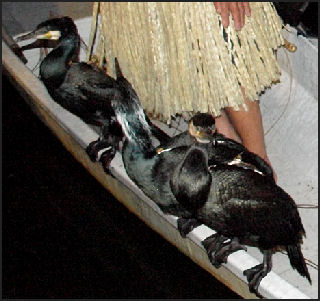
Around 45 boats offer tours. They take off around 6:00pm just before sunset and travel several kilometers upstream to the fishing spots. Along the way visitors can catch glimpses of Mt. Kinka and other stunning scenery. Before the fishing starts a fisherman explains the that fishermen wear black so the birds can’t see them, cover their heads for protection against sparks and wear a straw skirt to repel water. Pinewood is burned because it burns even on rainy days and the cormorants are not fed all day so they will be hungry at fishing time. The birds are all caught in the wild and trained. Some can catch 60 fish an hour.
The fish are squeezed out the neck. Many visitors find this cruel but the fishermen point out that captive birds live to be between 15 and 20 while those that live in the wild rarely live beyond five. A ride of a tourist boat costs ¥3,300 per adult. For information call ☎ (058)-262-0104.
Websites: Gifu GovernmentGifu Government ; Gifu TourismGifu Tourism ; Photos of Cormorant Fishing Photo Travels
Cross Country Skiing: See Skiing.
Diving and Snorkeling: See Sea-Related Activities
Fishing in Japan
Japan offers reasonably good trout, bass and salmon fishing in its 32,000 rivers, streams and lakes. Sport fishermen can enjoy fly casting and wet fly casting. Fishing rod and fly making are regarded as traditional crafts practiced by skilled craftsmen.
The fishing in some rivers is negatively affected by the construction of dams and concrete river banks, erosion and other problems caused by artificial forests and the fact that there are more fishermen than the rivers can handle and all practically all the fish get caught. Fish are more plentiful in catch and release zones. The whole idea of catch and release is relatively new in Japan, where fishermen have traditionally looked upon eating what they catch with great pleasure.
Almost all rivers and lakes are managed by 850 local fishery cooperatives. Anglers are required to buy a one day pass (around ¥1,000) or a season pass (between ¥4,000 and ¥10,000) to fish. These are usually sold at local co-op offices, fishing tackle stores or convenience stores near rivers and lakes. Fishing outing are often organized through fishing outfitters in towns near major fishing rivers, streams and lakes.
Fishing on your own takes some research. Since fish regulations vary from place to place, inquire about licenses and regulations at the hotels or local tourist offices. Most rivers and lakes have their own fishing season. Many open in February or March and close at the end of September. Fishing during the off-season (especially during spawning) is banned. There are a few lakes, such as Kawaguchi and Motosu near Mt. Fuji, that are open to fishermen the entire year.
Fly fishermen go after introduced rainbow, brook and brown trout. Popular fly fishing places include Lake Ashinoko near Mt. Fuji, the Kannogawa River in Gunma Prefecture, the Sagae Rover in Yamagata Prefecture, streams near Oshino village in Yamanishi Prfecture, and the Nagara River and Mugi River in central Gifu Pefecture.
In many rivers fisherman catch sweet ayu fish.. Fishing for black bass — an alien fish regarded as pest by many but loved by some sports fishermen — is popular on Lake Biwa, Japan’s largest lake, near Kyoto.Some rivers in Hokkaido are famous for salmon fishing.
Fishing (Saltwater): Deep-sea fisherman go after swordfish, blue, black and Pacific marlin, mako, thresher and hammerhead sharks, and yellow tail and yellowfin tuna. Sport fishermen can enjoy surf casting, night fishing and long line fishing and slow or fast trolling. Deep sea fishing is usually organized through charter boat companies in the major seaside resorts and is expensive. Many fishermen fish from beaches, piers, rocks and breakwaters and catch a variety of fish.
For more information contact Japan National Tourism Organization. Websites: Fishing Japan Fishing Japan ;Fishing Japan top sites Fishing Japan top sites
Flying: Sea Air Sports.
Gardens in Japan
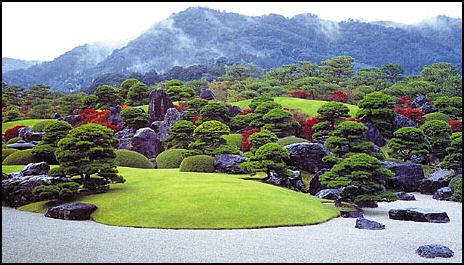
Adachi musuem garden Japan is famous for its gardens. No Japanese house, palace or temple is considered complete without a garden. Japanese gardens, however, have little in common with the grand, geometric, gardens of Rome, the Moghal empire in India, France and England, nor are they similar to Western gardens with their neat hedges, careful patterns and colorful flowers that bloom on a rotating basis.
Instead Japanese gardens feature moss-covered dirt and rocks, paths that never seem to follow a straight line, rocks that have special significance and a layout plane that harmonizes with the natural surroundings that sometimes embraces mountains 10 or so kilometers in the distance. Beautiful gardens are found throughout Japan with some of the most famous one found in Kyoto, Kanazawa and Kumamoto. You can find gardens listed under tehse cities in Places.
Websites: Japan Guide List of Gardens Japan Guide ; Gardens in Japan Garden Visit ;
Gays: The web site Japan Visitor is a good source on gay life in Japan. Website: Japan Visitor Japan Visitor
Golf in Japan

Golf is very popular in Japan. Japan has the second largest golf market in the world after the United States. There are around 10 million golfers and 2,450 golf courses in Japan (compared to 25 million golfers and 13,600 golf courses in the United States). Around $3 billion in golf equipment is sold every year. Japan is also full of multi-story driving ranges.
Playing golf is often an all day affair in Japan. Many golfers have to drive several hours to get to a course. Once they are there they play very slowly, an average of 5½ hours per game. By contrast most American can reach a course in 15 minutes and often can play 18 holes within three hours.
Some Japanese golf courses have automatic, radio-controlled robot caddies that move golf bags from to hole to hole on monorails. Others have escalators on steep slopes. Many of the caddies are women who wear blue uniforms and towels and huge bonnets on their head.
Golf can be very expensive in Japan. Some of the most exclusive golf clubs in Japan have clubhouses with paintings by Monet and Chagall and bathrooms with solid gold fixtures. Green fees for a single game can cost $600 or more and memberships at leading golf courses can go for up to $1 million. Many Japanese golfers find it cheaper to fly to a Hawaii or Thailand to play golf than to play golf at home.
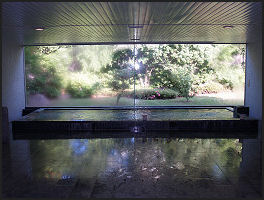
club house bath Many expensive clubs went bankrupt in the 1990s after the collapse of the Bubble Economy and were purchased by American management companies which has shaken up the golf course business in Japan. Today there are basically two kinds of clubs in Japan: 1) high end courses that have survived: and 2) lower end, semi-public courses with lower fees for members and visitors. A typical semi-public courses has lowered its weekend green fees to ¥6,000, a third of what they were in the 1990s. No-frills public courses such as Kita-Kishigaya along the Edogawa near Tokyo have green fees of $40 for weekends and $30 for weekends.
Visitors are often welcome to play on private courses during the week when they are not crowded but are often not welcome during weekends when they are crowded. Call the course's caddiemaster to arrange a time. Many clubs require a maximum of handicap of 26 or 28. Remember to bring your handicap certificate and a copy of your U.S. club membership. Few staff members speak English.
Websites: Golf in Japan (membership site) Golf in Japan ; Golf Courses in Japan Worldgolf.com ; Tokyo golf courses open to non-Japanese Success Stories ; Golf courses in Japan Golf Today Book: There is an English-language guide “ Gold Course Guide to Tokyo” .
Handicapped Travel is somewhat developed in Japan. The airports and many buildings in Japan have elevators, ramps, wide doors and special bathrooms for handicapped people. Handicapped parking spaces are clearly marked. Many sidewalks, road crossings, intersections, stairways and train and subway station platforms have yellow strips with raised dots and dashes that help blind people navigate their way around and avoid injury.
Still, even with all this and a lot the high-tech gadgetry too, difficulties abound for handicapped people. Only 43 of Tokyo's 235 subway stations have elevators. In many cases wheelchair users have to page an attendant to carry them up and down the stairs. Blind people worry about getting hit by cars and falling off train station platforms. Website: Guide for wheelchair users Tesco-Premium
Hash Harriers are a social club popular with ex-patriots overseas. Once a month or so on a weekend day the Harriers sponsor an event that is half running race and half scavenger hunt. Some participants take the race seriously, but most drink a few cold ones and have a good time. For information about local Hash Harrier groups try contacting the American, British or Australian Embassies. Hash House Harriers (www.ghhh.com) calls itself a "beer drinking club with the running problem." Founded in 1938 in Kuala Lumpur, it has more than 1,300 chapters worldwide. Website: List of Hash Harriers in Japan Kobe Hash
Hiking, Mountaineering and Parks in Japan
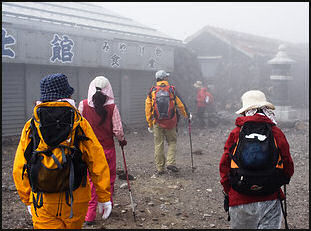
hiking on Mt. Fuji Hiking is a very popular activity in Japan as the lines of people climbing Mt. Fuji at three in the morning attest. There are thousands of miles trails and paths. Hikes vary from easy strolls through the forest to challenging ridge walks. There are also towering cliffs and glacier-covered peaks to challenge the most experienced mountaineers. The choices are endless but getting to the trail heads is sometimes a problem unless you have car.
Japanese hikers often use walking sticks and wear special outfits and have all kinds of special stuff. The main hiking season is from May to October, but conditions vary greatly from place to place. The spring is nice because the mountains are still covered with snow. In the early summer and late spring wild flowers are in bloom. In the fall, autumn leaves are on display. Winter hiking and snowshoeing are surprisingly popular in Japan, especially among seniors.
The hiking trails are generally well marked and well maintained but signs are often only in Japanese. Make sure you have a map. A map in Japanese is okay even if you don't speak Japanese (you can always ask a Japanese hiker if you are on the right the trail by pointing).
There are many wilderness huts in Japan's parks and hiking areas. Most of these places are four or five hours apart on the popular hiking tracks. They usually have bunks (sometimes with mattresses), water supplies and outhouses. Some contain cooking capabilities and fireplaces. Some are free. Some charge a small fee. Others charge $50 to $80 and provide meals.
More than 70 percent of Japan is covered by mountains and forests. There are 28 national parks and 55 so-called quasi-national parks. They make up 15 percent of national territory. Some of national park land is privately owned and their main purpose in not to protect wildlife or wilderness areas but to provide recreational areas for visitors and money for local people.
The use of parks is free. Passes often need to be obtained from park headquarters for overnight stays in back country huts. Maps and directions may be obtained from local tourist offices and park headquarters.
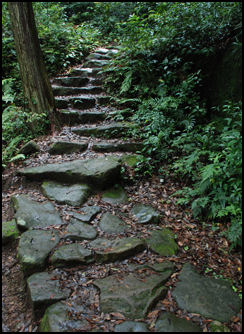
Kumano Trail Popular hiking areas include the Japan Alps, Nagano area, Mt. Fuji, the national parks in Hokkaido and the Kumano trail in Kansai and Wakayama. The Okutuma area (1½ hours from Tokyo) and the Oku-Chichibu offer some of the best hiking in the Tokyo area. See Nagano, Japan Alps, Kamikochi, Hokkaido, Kyushu National Parks, Kumano Trail, 88 Shrines in Shikoku and Hikes Around Tokyo Under Places.
Among the groups that sponsor hikes in the Tokyo are the International Adventure Club (www.iac-tokyo.org ) and Friends of the Earth (e-mail infoo@foejapn.org ). Hiking clubs, organizations and schools include the National Camping Association of Japan, Outward Bound Japan (www.feis.com/obs).
Outdoor Japan (www.outdoorjapan.com ) has a lot of information on hiking, rock climbing and camping.
JNTO has some hiking guides and brochures, Local offices often have brochures and guides for their area. Books include “Hiking in Japan” by Paul Hunt (Kodansha, 1988); Lonely Planet’s “Hiking in Japan” and “100 Famous Peaks in Japan” by Nihon Hyaku Miezan. There are dozens of guides in Japanese.
Websites: Hikes in Japan Japan Hike ; Japan hiking links Trail Data Base ; Chris’s Hiking blog Chris’s Hiking blog ; One Hundred Mountains Blog One Hundred Mountains Blog ; Outdoor Japan Outdoor Japan
Horseback Riding is not very popular in Japan. There are some riding trails, which pass through farms, mountains, forests, beaches and pastures. Half-day, day- and multi-day guided rides are offered in some areas. Hokkaido is the main horse breeding area of Japan. Farms and riding centers outside the main cities offer rides oriented for kids. Google “horseback riding in Japan” and see what you come up with.
Hot Spring: See Onsens
Hunting: Hunters in Japan go after wild boar, pheasants, deer, hares, ducks, doves and sometimes bears. There are special rules for registering and storing guns. Somew Japanese complain that hunters approach too close to residential areas. I’ve encountered them on hiking trails.
To obtain a hunter’s license one must listen to lectures and pass two tests in Japanese: the first is on laws; the second is firearms safety and animal identification. The fee for the license is approximately ¥30,000 per year. Every three years a hunter must take a refresher course and submit new paperwork. To own a gun one must go to the police and make a case of why you need one. If the request is approved the applicant needs to take two tests on law and safety. Upon passing the tests one can apply for a permit for a particular kind of weapon. Upon purchasing a weapon one must register it with police, confirm that it is kept under lock and key at all times and submit to a background check. Each year the weapons must be brought to the police at a specific time for a check.
Kayaking: See Canoeing, Kayaking and White Water Rafting
Motorcycle Touring is popular in Japan. Motorcycles can be rented.
Mountain Biking: See Bicycling.
Mountaineering: See Hiking, Mountaineering and National Parks.
National Parks:See Hiking, Mountaineering and National Parks.
Nordic Skiing: See Skiing.
Onsens in Japan
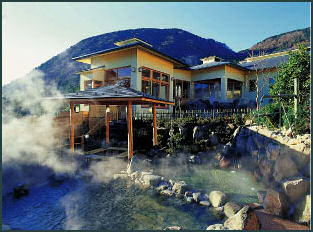
Hakone area onsen Japan has 19,445 thermal resorts and spas, known as onsens, scattered across the country and they welcome about 130 million people a year. There used to be more. Many of them offer mineral baths, health activities and massages. Unlike European spas people generally don't drink the water but bath in it (but some places do encourage visitors to drink it to). Many offer accommodation and meals.
Onsens offer a variety of baths and bathing experiences: individual, communal, inside, outside, mixed or single sex baths, cold baths, hot pools surrounded by trees and rocks, warm water swimming pools, black sand baths, mud baths, baths of graded temperatures, mineral baths, waterfalls, walking pools, cold pools, jacuzis, steam rooms, swimming pools with water slides, outdoor pool with bars, baths scented with small floating bags of citron and orange peel, and herbal baths.
Some onsens have baths that contain salt imported from the Dead Sea, allowing bathers to bob and float as of they were in the Dead Sea. Others have radioactive water with radon that is supposed to improve your health. Contradicting what many people think, one study in Japan found people who lived around a hot spring with high levels of radiation have lower cancer rates than the general population. Some onsen go to great length to get their water. Some of Tokyo’s 144 hot spring wells pump from depths up to 1,700 meters underground
There are two kinds of baths: “notenburo” (“indoor baths”) and “totemburo” (“outdoor baths”). Here are also baths only for men (“otoko-yu”), only for women (“omna-yu” and mixed gender ones (“konyoku”). The Japanese have a n expression for the social boding that takes place in a bath: “hadaka no tsukiai” (“naked companionship”).
Hot springs have long been thought to have healing powers, There are stories of samurai bathing themselves after battles and farmers seeking them to cure their cuts and sore muscles, In the 19th century one the main goals of some early train lines was to make hot springs more accessible to the cities.

onsen in North Honshu Some baths have mineral waters that purportedly treat a host of illnesses. Some of the baths have clear water. Some have a reddish tint. Others are grayish. Each bath is said have curing powers for a different ailment. These baths often have the mineral content listed and the ailments that each mineral treats. Some of the nicest onsens have huge painting in the dressing rooms and feature cypress wood baths that give off a pleasing aroma when filed with hot water.
In the old days, men and women went nude in the mixed sex baths. That is no longer the case. Most of onsens have segregated indoor and outdoor baths for men and women. Some have a large outdoor bath (“rotenburo” ) where men and women can bath together in bathing suits or with a towel wrapped around them. But as a rule swimsuits are considered unsanitary.
In the Amoiri area you can still find mixed sex bathes where men and women bath naked together. In some other places mixed baths are making a come back and they get a surprising number of women. Although some of them complain about alligators (men who cruise around they baths with their eyes just above the surface of the water, checking out women’s bodies).
Onsens Accommodation: Onsens usually offer accommodation and meals. Ends to themselves they usually have several baths and are popular weekend trip destinations, particularly for women. Many resemble large hotels and have indoor baths. Other are more like country inns and have indoor and outdoor bathing facilities. Some baths are reached only after taking a hike through the mountains.
Some are quite luxurious: filled with artworks and an army unIformed employees relentlessly saying “excuse me” and “thank you” for this and that. Prices range from $70 to $500 per person per night, including a large dinner and small breakfast. Day trippers who don’t spend the night are charged between $5 and $10.
The room are often simple Japanese-style room with tatami mats and a low table and futons that are unfurled at night. The meals are set and offered at a specific time. Often times onsens meals are served in the guest’s room. They often contain a variety of vegetable, pickle and fish dishes, served artistically in small amounts.

onsen in North Honshu Many onsens have transfer service from the trains stations. This is usually in the form a small van that picks up guest outside the station and take them to the mountains where the onsen is located. Once guest arrive they shed their clothes and put on bathrobe-like yukatas and are given towels. Many onsens in the mountains have hiking trails around the facility. Guests squeeze in hikes between meals and baths. Many are open late into the night and allow guest to drink sake while they are taking a soak.
Onsens Etiquette: See Baths, Hygiene
Onsens Troubles: A study found that even though most onsens claim to be natural hot springs, 70 percent use water that is pumped up from underground. Only 30 percent were real hot springs in which natural water bumbles to the surface. So much water is in being pumped from underground there are worries it may dry up hot spring water supplies.
In one survey a third of the onsens admitted they diluted the hot spring water with tap water. Half said they recycled water through filters and 40 percent failed to respond. Other studies and research have uncovered onsens that had water trucked in from other places, or ran it over mineral ores so it could be labeled as mineral water. Others have dangerous bacteria. At one Onsens in Miyazaki Prefecture, 295 bathers became ill and seven died from a mass legionella infection caused by contaminated water.
In 2003, it was revealed that one onsen famed for its milky-white water added a powder to the water to give it the milky color. Further investigation found that several other onsens used similar tactics to give their water unique colors or characteristics. In some cases the onsens originally had uniquely colored water but after supplies began running low additives were added out of fear that tourist would no longer come. In recent years an effort has been to regulate the onsen industry so that onsen live up to their claims. Some that has added tap water ir run misleading ads have been criminally charged.
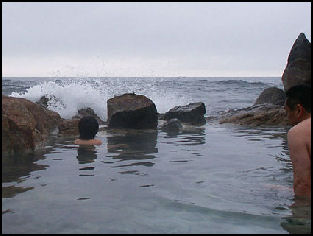
Shirahama onsen Revelations of water tampering have hurt an industry that was already in a state of decline. Some people with reservations have called and demanded their money back. Onsens that didn’t tamper with their water have been hurt as much as those that did. A couple onsens were shut down after police raids. Onsens are currently closing at a rate of 100 a year.
Popular Onsens: The most popular Onsens areas accessible to Tokyo include Atami and Shomoda on the Izu Peninsula, Kusatsi in Gunma, Kinugawa in Tochigi, and Hakone in Kanagawa. Popular onsens in the Kansai area include the Kurama Onsens near Kyoto and Ashima Onsens near Kobe. In Kyushu there are many hot springs in Beppu and Kagoshima. See Places
Book: “A Guide to Japanese Hot Springs” by Anne Hotta (Kodansha, 1986) and “Japan's Hidden Hot Springs” by Robert Neff (Tuttle, 1986). For more information try Japan Spa Association (☎ 03-3231-1640, Spa.org )
Websites: Good Onsen List with PicturesJapanese Guesthouse Onsen Map with Mixed Sex bathsSecret Onsen ; Onsen GuideHot Springs Michelin ;
Parachuting: Sea Air Sports.
Paragliding: Sea Air Sports.
Pets can not be brought into Japan by visitors.
River Trips: See Canoeing, Kayaking and White Water Rafting.
Rock Climbing: See Hiking, Mountaineering and National Parks There are several indoor climbing gyms in the Tokyo and Osaka areas.
SailingSee Sea-Related Activities
Skiing in Japan
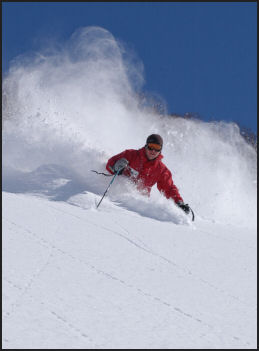
Japanese powder Downhill skiing, cross-country (nordic) skiing, snowboarding, and night skiing are all offered in Japan. The ski season generally runs from mid December to mid April, but conditions vary a great deal from place to place. The heaviest snowfalls and best skiing usually occur from January to mid-February. During April the temperatures are moderate.
Japan once had a reputation for super crowded ski resorts but that is no longer necessarily the case. The ski boom that peaked in the late 1980s and early 1990s has been over for some time. The number of regular skiers nationwide has dropped form 18 million in 1992 to 10.5 million in 2001. This means, with the exception of resorts accessible to the large cities, short lift lines are the rule not the exception. The decline in skiers has meant that many ski resorts have lost money and some have closed.
“A winter vacation at a Japanese resort area means more than just sports. Like so many other aspects of modern-day living, the pace of recreation in Japan has accelerated and the ways in which people enjoy winter sports have changed. Previously, this would have involved staying in a “ryokan “(Japanese inn), or family-run bed-and-breakfast, and enjoying pleasures such as hot springs, the beautiful landscape, and of course skiing. Recently, however, there has been a surge in the number of ski resorts that have large hotels offering a wide range of facilities, and now there are a great many more things to do than just ski. They feature a variety of restaurants including those with Japanese, Chinese and European cuisines, golf courses, shopping malls and beauty spas. These days, winter resorts offer much more than sports. [Ibid]
“The availability of domestic package tours that include transportation, hotel, meals, ski lift tickets, and so on, has made the business aspect of winter sports much more competitive. To kindle consumer interest, resorts have responded by promoting discount packages and offering new styles of skiing, such as freestyle and Telemark skiing. The popularity of snowboards has grown so rapidly that nearly all ski areas in Japan now permit snowboarding. This has required the adoption of additional safety measures. As they have changed to better suit modern life styles, in recent years ski resorts have seen a huge rise in the number of customers from abroad as well as those from Japan. Hokkaido, which is known as the biggest winter resort area in Japan, saw a 500 percent increase in overseas visitors in the 10 years through 2006 as it gained recognition as an international ski resort destination.
Avalanches can be a problem especially among those who like off-piste runs. In 1999, three New Zealand snowboarders were buried by an avalanche when they ignored signs and boarded in an area near Happo-One in Nagano.
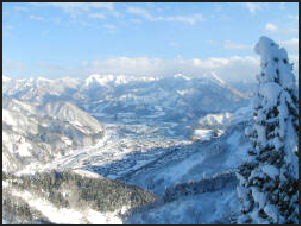
Ski Areas: Hokkaido is famous for having some of the best powder in the world. This is because the temperatures are perfect for creating powder and there are not the kind of extreme temperature fluctuations that melt and freeze snow and make it icy as is often the case with higher elevation ski resorts in the United States and Europe. Recommended resorts in Hokkaido include Niseko, Furano, Kiroro, Risutsu and Tomamu.
Tohuku (northern Honshu) is known for its good snow and harsh winds. The most popular resorts here, the well-designed Appi and traditional Yamagata Zao Onsen, are near mountains covered the hoar-frosted, pure white trees known as “juhyo” ("snow monsters).
“Hokkaido’s northern latitudes permit skiing from early December to late April. Most of the ski grounds provide a variety of slopes that offer not only challenges to experts, but safe skiing for beginners. Many of these ski facilities are located close to Hokkaido’s major cities. Skating can be enjoyed at many lakes and outdoor rinks, and also in some urban areas. Hakone, a recreational area near Mount Fuji, offers good skating facilities. It can easily be reached from Tokyo by train in less than two hours.
Ski Resorts in Japan
There are more than 600 ski resorts in Japan. They vary great in size and character and are different from resorts in Europe and the United States. Cable cars, for example, are called ropeways. Popular resorts near the cities are often characterized by crowded slopes and loud music blasted from loudspeakers.
Most of the resorts have hotels which are often full during the winter. Make sure to make reservations well in advance of your arrival date. The prices aren't cheap. But they are not outrageous either. Lift tickets are usually around $40, a room in a new hotel is $160. Package deals with room, lift ticket and transportation can be had about $100 a day. Equipment such as skis, ski boots, cross country skis, snowboards, skates and toboggans can be rented. The cost for rental ski or snowboard equipment is around $50 a day. Ski instruction is also available.
Most of the major winter sports areas on the island of Honshu are easily accessible by railway and are outfitted with chairlifts and night illumination. A large number of ski grounds are located along the Joetsu line, which terminates in Tokyo. These include Tsuchitaru, Nakazato, Iwappara, Yuzawa, Ishiuchi, Shiozawa, Urasa, Koide, and Ojiya. Sugadaira Ski Grounds is a ski resort located along the Shinetsu line, between Mt. Azumaya and Mt. Neko. Zao, a resort on the border of Miyagi and Yamagata prefectures, has the reputation of being the largest and best equipped ski area in the Tohoku region. It is also famous for its “snow monsters” — ice-covered pine trees that make for stunning winter scenery. [Source: Web-Japan, Ministry of Foreign Affairs, Japan]
In north central Honshu there is good skiing in Kanetsu, Hinetsi and Chuodo, which includes Niigata, Nagano and Gunma prefectures. Here there are scores of resorts. Serious skiers often head to resorts where the skiing events from the 1998 Nagano Olympics were hosted, such as the giant Hakuba and Shiga Kogen clusters. Nozawa Onsen in Nagano prefecture is popular
In Niigata Prefecture the are dozens of small and medium size resort like Gala Yuzawa (with its own Shinkann stop), Joetsi Kokusai or the upmarket Naao Ski Garden. Naeba and Tashiro are home to the world's longest gondola ride.
There is good skiing at Tenjindaira in Gunma Prefecture, just three hours from Tokyo and 20 minutes up a ropeway. Near Osaka and Kyoto there is descent skiing in the Lake Biwa area but the conditions are unreliable due to waves of warm weather blow through the area..
There are eight indoor ski centers in central Japan including two in the Tokyo suburb of Funabashi. The operate year round.
Check out “Ski Japan-The Complete Guide to Japanese Ski Resorts” by T.R. Reid (Kodansha International, 1994). Beltop Travel (☎ 03-3544-0939, website: www.belltop.com) in Tokyo specializes in arranging ski trips for non-Japanese.
Websites: Ski Japan Guide Snow Japan with information on 600 ski resorts, trail maps for 150 resorts and weather conditions and snow reports; Ski Japan.com Ski Japan.com ; Deep Powder Tours Deep Powder Tours ; Holiday Niseko holidayniseko.com/niseko-accommodation ;
Snowboarding: See Skiing.
Snowshoeing trips are operated by Edelweiss tours from Yonezawa in Yamagata Prefecture. Snowshoes have metal-rimmed plastic membranes and clawlike grips. See Yamagata Google “snowshoeing Japan” and quite a few places show up.
Spas: See Onsens
Swimming and Beaches See Sea-Related Activities
Surfing: See Sea-Related Activities
Tennis: Most resorts and large hotels have their own courts. There are also indoor and outdoor courts in almost every city and large town. A good place to look for an available court is a university. Most of the time the court surface is clay or cement.
Turtle Watching See Sea-Related Activities
Trekking: see Hiking, Mountaineering and National Parks.
Walking: See Hiking
Whale Watching See Sea-Related Activities
White Water Rafting in Japan

white water in teh Kyoto area White Water Rafting is offered on the Tone River near Minakami in Gunman prefecture (150 kilometers northeast of Tokyo) and through the Nagatoro area and Iwadatami rock formations on the Arakawa River in Saitama near Tokyo.
The rafting season lasts from April to October. April, May and June are often the most popular times because that is when rivers are swollen with water from the spring melt and the June rainy season. Trips range from a half day to five days and vary from calm cruises on gentle water or wild rides on rivers after dams have been released.
A serious white water raft trip with Class-4 rapids are offered on the Yoshino River in Shikoku. The trip is not for the pampered. It involves overnighting in tents and often putting up with rain and rough conditions. It is not uncommon for the rafts to overturn in the big rapids. Part of the trip is spent drift with the current in a life jacket. For more information check out www.happyraft.com happy raft
Hozu River Trip (accessible by the JR San-in line from Kyoto Station) is done in long narrow boats. The down river trip begins at Kameoka Station and takes one hour and 45 minutes to cover the 16 kilometer distance to the finishing point at Togetsukyo Bridge in the middle of Arashiyama. The route was first used in 1606 to carry rice and vegetables from local farms to Kyoto.
Boats operate on Hozugawa river all year. The spring rafting season begins in March. On the busiest days of the year in October and November up to 100 boats make the trip. Each boat is propelled forward by a punter and oars man and steered from the back by a helmsman. Up to 30 people can ride in each boat. Most of the journey is in swift but relatively calm waters. There are a couple of exhilarating stretches through small rapids but nothing large. Wildlife seen in the mountains includes herons, nightingales, deer, boars and monkeys. The cost of the trip is ¥3,900 for adults and ¥2,500 for children.
Doro-kyo Gorge (near Yumomine Onsen in Wakayama, four hours from Nara by bus) is the site of a popular dramatic two-hour boat trip. The trip is done on glass roofed boats and cost about ¥3,300. Many people consider Doro-kyo Gorge to be one of the most beautiful gorges in Japan. Whitewater trips are done from Kamikitayama-mura to Dor-hatch via the Doro-kyo Gorge on unusual rafts on which riders stand up single file.
Websites: Rivers and Creeks in Japan Rivers and Creeks in Japan ; Outdoor Japan Outdoor Japan ; Canyons.jp Canyons; www.happyraft.com happy raft Also see Canoeing, Kayaking
Winter Sports in Japan
The popularity of winter sports in Japan is substantiated by the country’s distinction of being the first Asian country to host the Winter Olympics (1972). Further proof can be found in its role as host to both the first and second Winter Asian Games (1986 and 1990). To these, of course, the 1998 Winter Olympics in Nagano can now be added. [Source: Web-Japan, Ministry of Foreign Affairs, Japan]
“Japan’s climate, above all, permits a thriving winter sports season. Winters are governed by the coldest air mass in the world, the Siberian air mass. The frequent approach of cold fronts from the Asian mainland causes Japan to experience much lower temperatures than European regions at the same latitude. Tokyo, at 35̊ north latitude, has an average January temperature of 4.7̊C, as opposed to the similar 4.2̊C January average in London, located at 51̊ north latitude. As the Siberian air mass approaches Japan, it picks up moisture from the Sea of Japan. As a result, regions facing the Asian continent often receive heavy snowfall. Joetsu City in Niigata Prefecture recorded 232 centimeters of snow in one day during 1986" enough to bury a one-story building. This presents a startling contrast with the Pacific attracted Ocean side of the archipelago, which tends to be quite dry and receives much less snow during the winter. [Ibid]
“Another factor that enhances the winter sports environment is that four-fifths of Japan’s land area is composed of mountains. The Japan Alps “a range that is divided into Northern, Central, and Southern sectors” runs down the central part of Honshu, the largest of the four Japanese islands. Many peaks in the Japan Alps are over 2,500 meters high and are covered with snow during the winter. Since these areas can be reached easily by the rail and highway network from the three major population centers in Kanto, Chubu, and Kinki (with Tokyo, Nagoya, and Osaka, respectively, at their centers), it is natural that these areas are among the most popular for winter sports. A skier, for example, can board a Joetsu Shinkansen (bullet train) on a brisk and sunny day in Tokyo, and in just over one hour be at a resort in Niigata Prefecture or Nagano Prefecture where there are two to four meters of snow. Depending on the region and prevailing weather conditions, it is usually possible to ski from December through the beginning of April. [Ibid]
Image Sources: 1) Okinawa Convention and Vistors Bureau 2) Freewheeling bike tours 3)Ehime Prefecture Tourism 4) 5) Wolfgang Kaeler, International Wildlife Adventures 6) Sado island tourism 7) JNTO 8) Ray Kinnane 9) Adachi Museum 10) 11) Golf in Japan 12) Andrew Gray Photosensibility 13) Kumano Kodo site 14) Kanagawa Prefecture tourism 15) 16) Onsen Express 17) Wikitravel 18) 19) Snow Japan 20 Kyoto Visitor
Text Sources: New York Times, Washington Post, Los Angeles Times, Daily Yomiuri, Times of London, Japan National Tourist Organization (JNTO), National Geographic, The New Yorker, Time, Newsweek, Reuters, AP, Lonely Planet Guides, Compton’s Encyclopedia and various books and other publications.
